| Columns Retired Columns & Blogs |
Is fig.6 into 4 ohms or 8 ohms? The main text says one thing, but the image says another. Thanks.
I performed the measurements of the Audio Note Meishu Phono Tonmeister with my Audio Precision SYS2722 system. The tubes were already installed when I received the review sample. I removed the cover to check for proper installation. All was well. I waited for 30 minutes after powering up the amplifier before starting the testing.
Looking first at its line inputs, the Meishu Tonmeister preserved absolute polarity, ie, was noninverting, from both the 4 ohm and 8 ohm output transformer taps. The maximum voltage gain at 1kHz was a moderately low 29.65dB from the 4 ohm tap into 8 ohms and 31.3dB from the 8 ohm tap into the same load. The input impedance is specified as 100k ohms. I measured a still-high 77k ohms at 20Hz, 74.5k ohms at 1kHz, and 63.7k ohms at 20kHz.
The source impedance from the 8 ohm output tap was a high 3.2 ohms at 20Hz and 1kHz, increasing slightly to 3.45 ohms at 20kHz. The variation in the small-signal frequency response with this output with our standard simulated loudspeaker (fig.1, gray trace) was therefore high, at ±1.8dB. The variation was lower from the 4 ohm tap, at ±1.1dB (fig.2), but with both output taps, there will be audible modifications of loudspeaker responses with almost all loudspeakers. Into resistive loads (figs.1 & 2, blue, red, cyan, magenta, and green traces), the Audio Note amplifier's output started to roll off below 40Hz and above 20kHz, reaching –3dB at 9Hz and 55kHz. Figs.1 & 2 were taken with the volume control set to its maximum; the excellent channel matching was preserved at lower settings of the control. There is the slightest hint of a resonant peak at 60kHz in the Meishu Tonmeister's frequency response, which correlated with some damped ultrasonic ringing in the amplifier's reproduction of a 10kHz squarewave into 8 ohms (fig.3).
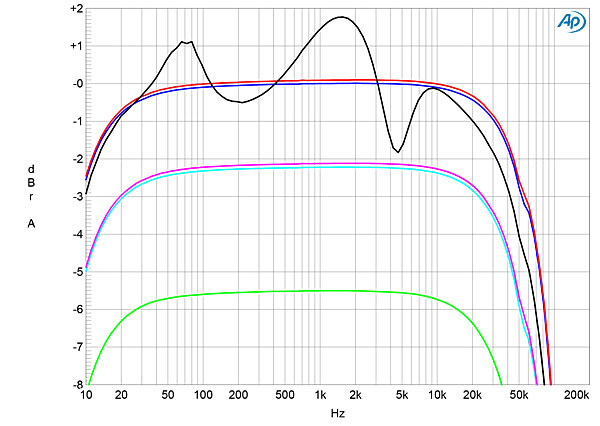
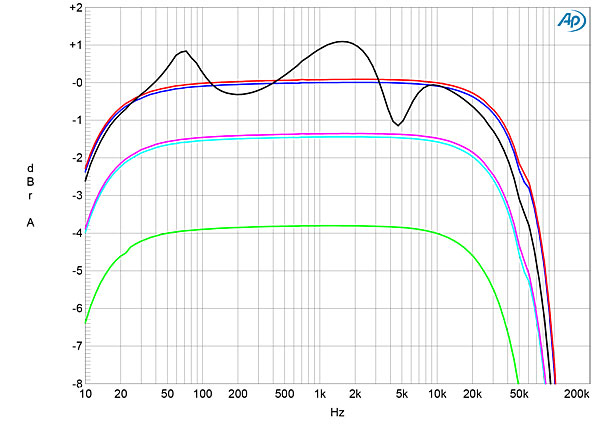
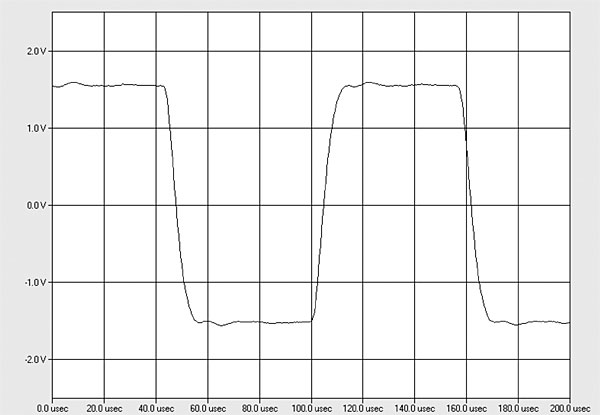
The Meishu Tonmeister's channel separation (not shown) was moderate, at 49dB, R–L, and 36dB, L–R, at 1kHz, respectively decreasing to 23dB and 40dB at 20kHz. The unweighted, wideband signal/noise ratio (ref. 1W into 8 ohms) taken from the 8 ohm taps with the inputs shorted to ground and the volume control set to its maximum was 69.7dB (average of the two channels). This ratio improved slightly to 71.5dB, left, and 69.6dB, right, when the measurement bandwidth was restricted to 22Hz–22kHz, and to 86.7dB when A-weighted. With their lower gain, the ratios from the 4 ohm outputs were 1.3dB greater.
Spectral analysis of the low-frequency noisefloor while the Audio Note's 8 ohm taps drove a 1kHz tone at 1Wpc into 8 ohms with the volume control set to the maximum (fig.4) revealed a low level of random noise. However, AC supply–related spuriae at 60Hz and its odd- and even-order harmonics were present. The highest of these, at 120Hz, lay at –76dB (0.015%). Its level didn't change when I experimented with the grounding between the amplifier and the Audio Precision analyzer.
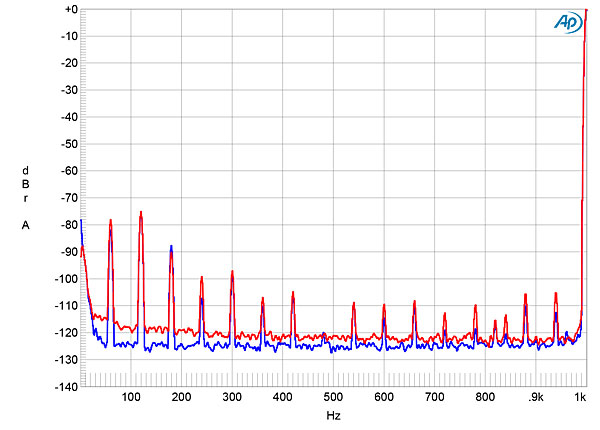
Audio Note specifies the Meishu Tonmeister's maximum power as 8W into both 4 and 8 ohms (6.02dBW and 9.03dBW, respectively), though no distortion percentage is mentioned. With our usual definition of clipping—when the THD+noise reaches 1%—and with both channels driven, I measured a clipping power of just 1Wpc from the 8 ohm tap into 8 ohms (fig.5) and from the 4 ohm tap into 4 ohms (fig.6). At 3% THD+N, I measured 4.8Wpc with each output tap matched to the load, and at 10%, 12.2Wpc from the 8 ohm tap (10.9dBW) and from the 4 ohm tap (7.9dBW), again with the taps matched to the loads. Less power was available from the 8 ohm tap into 4 ohms, but with the 4 ohm tap driving 8 ohms (fig.7), 5.75Wpc was available at 3% THD+N and 10Wpc at 10% (10dBW). The shape of the traces in these graphs suggests that the amplifier's circuit doesn't use loop negative feedback. It is also fair to note that the waveform wasn't actually clipped at these high levels of distortion; instead, it was asymmetrically rounded off.
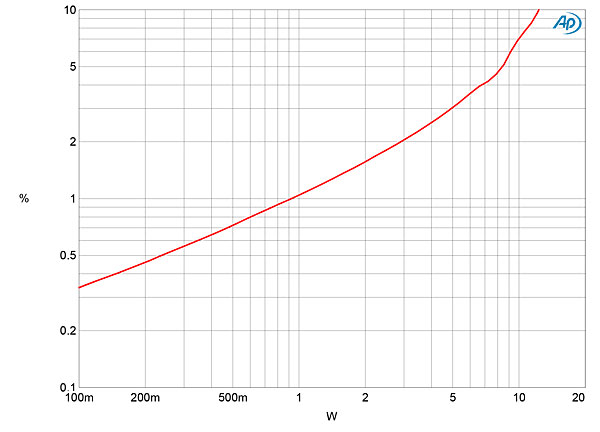
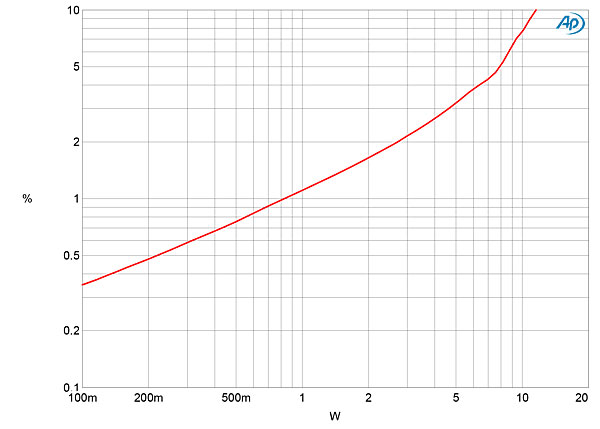
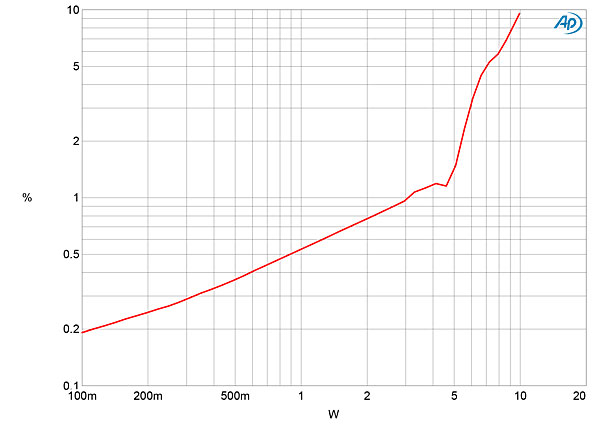
Figs.5–7 indicate that the lowest distortion at low power is obtained from the 4 ohm transformer tap. Fig.8 shows how the percentage of THD+N in both channels varied with frequency with this tap driving 8 and 4 ohms at 1V. The THD+N rose slightly at low frequencies and was significantly higher into 4 ohms (green and gray traces) than it was into 8 ohms (blue and red traces). At the same level from the 8 ohm tap (fig.9), the distortion across the audioband was close to 0.5% into 8 ohms and 1% into 4 ohms.
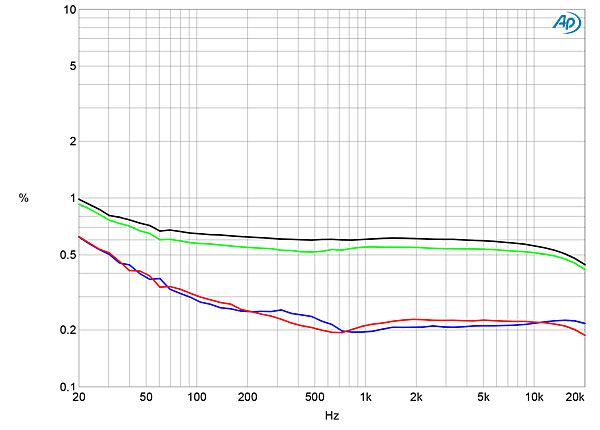
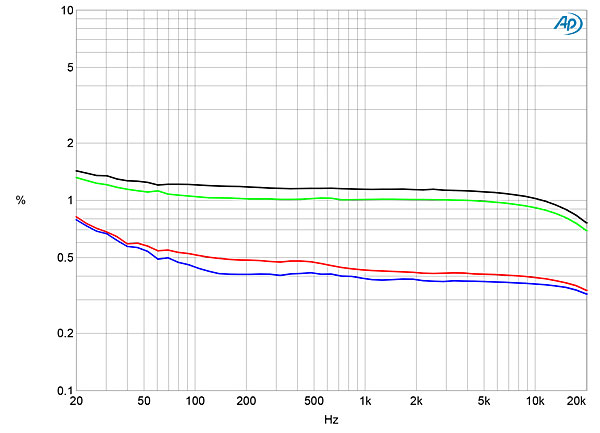
The distortion waveform (fig.10) was predominantly the subjectively innocuous second harmonic, with higher-order harmonics progressively lower in level (fig.11). However, the levels of the third, fifth, and seventh harmonics were higher at low frequencies (fig.12), which will probably be due to the onset of core saturation in the output transformers.
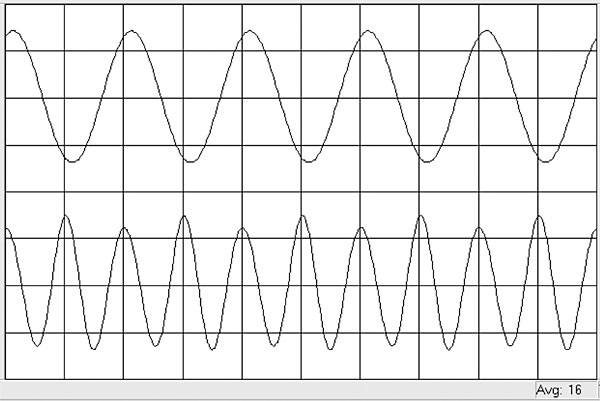
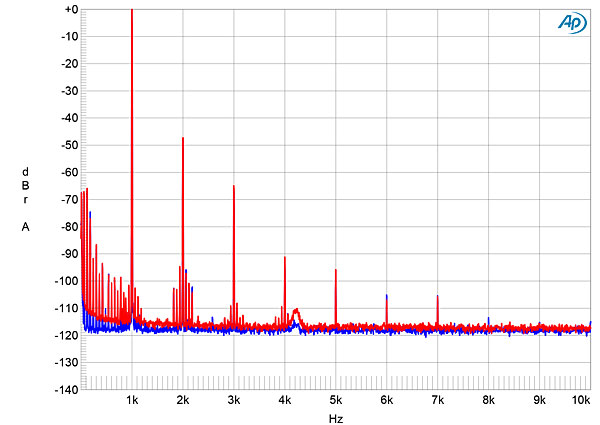
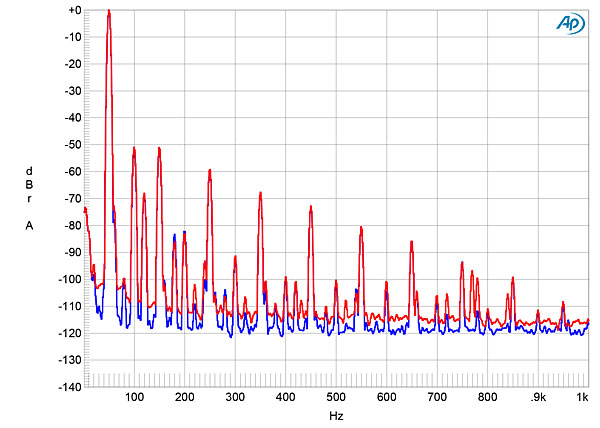
Due to masking, in itself the level of the second harmonic may not result in audible distortion, but this will only be true if it is not accompanied by intermodulation distortion. With the Meishu Tonmeister's 4 ohm taps driving an equal mix of 19 and 20kHz tones at 1Wpc peak into 8 ohms (fig.13), the 1kHz difference product lay just below –50dB (0.3%), with the higher-order products at 18 and 21kHz 10dB lower in level. This is marginal performance, in my opinion.
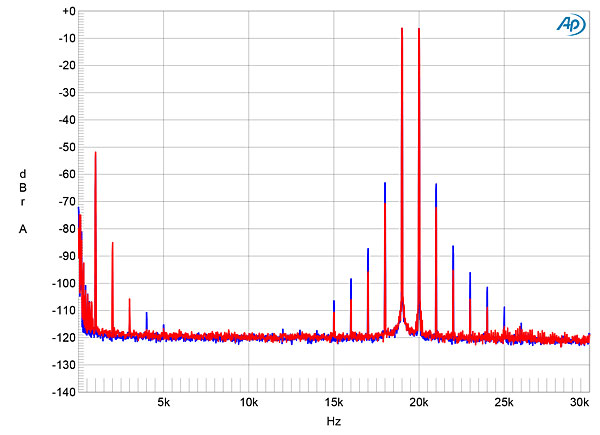
To examine the behavior of the Audio Note's phono input, I connected a wire from the Audio Precision's ground terminal to the amplifier's chassis ground post on its rear panel to obtain the lowest noise. The phono input preserved absolute polarity and the maximum gain at 1kHz was 67.8dB at the 8 ohm outputs and 66.14dB at the 4 ohm outputs. The gain was fixed at 36.4dB at the single-ended Source output, so, to avoid damaging the amplifier's output stage, I measured the phono input's behavior at the Source output with the volume control set to its minimum.
The input impedance is specified as 47k ohms. I measured 48k ohms at 20Hz, 37.5k ohms at 1kHz, but just 8k ohms at 20kHz. The phono input's RIAA equalization was very accurate, with excellent channel matching (fig.14), though the low frequencies rolled off a little, reaching –3dB at 16Hz. The wideband, unweighted S/N ratio with the inputs shorted to ground was a good 64dB in both channels, ref. 1kHz at 5mV. Restricting the measurement bandwidth to the audioband increased the ratio to 68.9dB, while an A-weighting filter further increased the ratio to 76dB. Negligible power supply–related spuriae were present in the phono stage's noisefloor (fig.15); this is a relatively quiet phono stage.
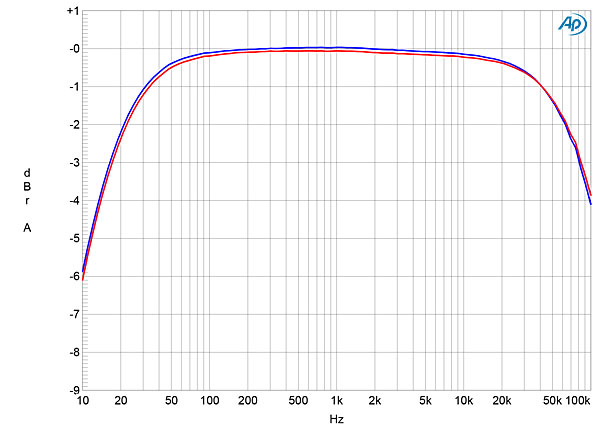
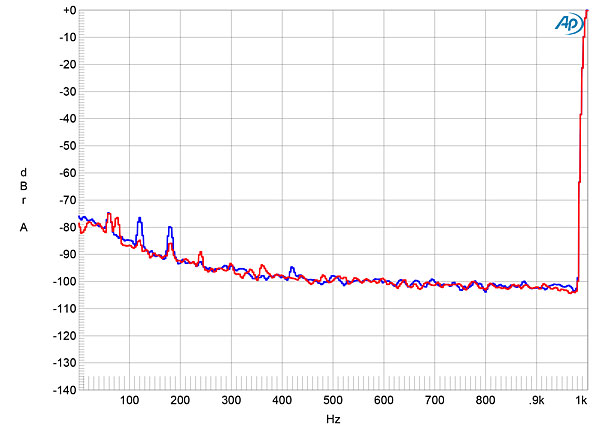
The low-frequency and midrange overload margins, calculated from the difference between the nominal 1kHz input level of 5mV and the input voltage where the THD+N reached 1%, were superbly high, at 37.8dB at 20Hz and 32dB at 1kHz. The margin at 20kHz was lower at 14dB. The phono input's harmonic distortion was respectably low in level, with the second harmonic the highest in level at –60dB (0.1%, fig.16). With the relatively low overload margin at the top of the audioband, I wasn't surprised to find that the second-order difference product with an equal mix of 19 and 20kHz tones peaking at 25mV lay at –40dB (1%, fig.17). High-order intermodulation products were vanishingly low in level, however, until I increased the signal level by 10dB.
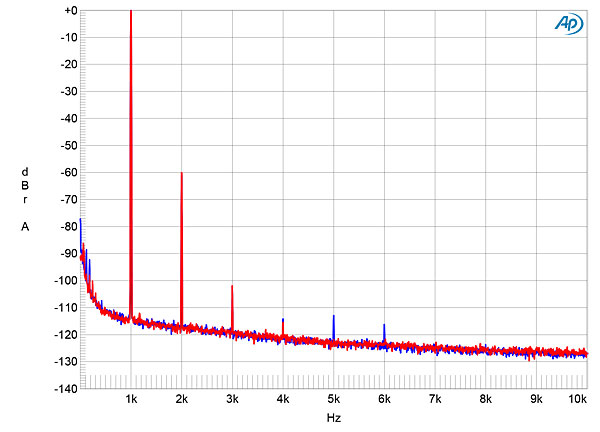
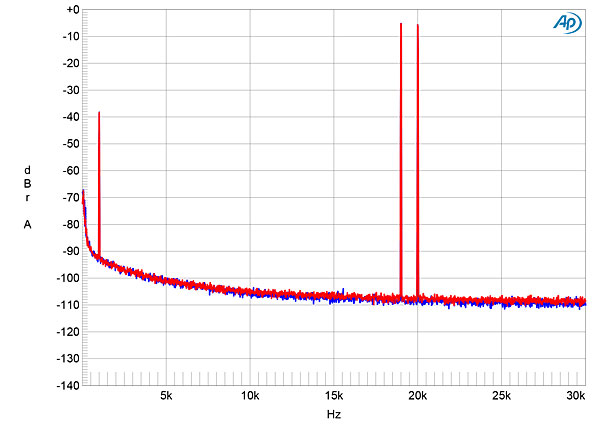
The Audio Note Meishu Tonmeister Phono's measured performance is what I would expect from an amplifier with a single-ended output stage that uses a single 300B tube for each channel. In this respect, its behavior resembles that of the Western Electric Type No.91E integrated amplifier that Ken Micallef reviewed in November 2022.—John Atkinson

Is fig.6 into 4 ohms or 8 ohms? The main text says one thing, but the image says another.
It's 4 ohms. Sorry for the error. I have corrected the fig.6 caption.
John Atkinson
Technical Editor Stereophile

An embarrassing set of measurements. This is an effects box, nothing more. It’s audio alchemy, not audio engineering.

...who's dabbled in things such as this component will immediately pick up at least half a dozen specific references in Ken's review as absolutely indicative of it's musical truthfulness. They connect and it connects.
We call this direct confirmation of the form and type and the very reason they exist.
How precious of you - commenting as Bonsai, ironically - to miss every last one of them. Back to your $499 cookie-cutter import.
Is this a free service you offer, this remarkable ignorance of not just that sonic form and style but somehow too its Japanese provenance, and is there a monthly newsletter? LOL.

The component is exactly like a bonsai tree in it's meticulous parts choice and placement, and it has been clearly 'trimmed' over time to produce beauty in several definitions of the word.
But nope, just the measurements matter. lol.

I'm well qualified to comment on the Audio Note stuff - not this specific piece of equipment, but the certainly the Audio note sound. I wandered into their demonstration room at a show I was participating in and even met brand ambasadoe Vincent (I bought his record as well :) ). Its nicely made it that type of thing floats your boat, but I really failed to see what all the fuss was about.
In the other hand, I listened at length to a big Nelson Pass amplifier driving a pair of KEF's and that was stunning.
Both idiosyncratic designs (one zero global feedback, the other 'low' feedback), but only one hit the spot.
I have no problem with people selling expensive gear, but, I have a serious problem with people who diss equipment out of hand without having heard it, or who claim feedback is bad. That is fundamentally flawed in my book.

and qualify them more accurately.
Your two sentence remark comes off completely flip.

Buy your astoundingly accurate, measurement perfect but ugly and dry sounding and oh so boring Benchmark or Topping crap. Enjoy using your radio shack lamp cord speaker wire with them too.

piece of work, John A doesn't give this a thumbs down engineering wise. More importantly, you tone deaf musical genius know it all, this is all that matters: "It may not do air; instead it does flesh. As is surely clear if you read this far, I found the amplifier's rich, brawny, physical reproduction more than satisfying."

What's wrong with effects box? If that's the sound certain people want, that's what they will get. I treat audio like food, you get the flavor you want and you pay for it, however expensive if you can afford it. If you want flavorless food, that's okay too.
I like looking at measurements myself and think they are important but it is to find the kind of measurements I prefer so I don't even need to read the subject reviews with their pornographic flowery prose as they don't meant much to me. Noise would be one example the subjectivists and objectivists can agree on: the lower the better. Basically I want everything to measure well, except benign harmonic distortion as long as it's pleasing to the ears without being grossly noticeable.

Is a wonderful description for such a magical musical sounding amplifier. ;)

Fig 3: is it a square wave @1 Khz (text) or @10 Khz (graph)?
Curious: this is perhaps the worst ever measured integrated I have seen in Stereophile,... but at the same time the word's best integrated according Ken. Clearly there is something measurements are not capturing... are you listening... err.. reading, Amir?

The thing is that clown has a horde of groupies, some of his followers making as aberrant and outrageous "tests" as the one done with Hegel, as the MQA case clearly demonstrates (which was as ignorant and evil-minded as it can possibly be), with even guys as Paul Gowan citing that clown act as a "engineering" proof of the alleged faults of the format... omg...
These ASR guys are dangerous (the damage they did to MQA is immense I think), and that's the whole point they do it I guess. What a deception that even Darko put one of them with his serious, phony voice on stage recently...
That aside, I can't find any possible justification for a 8 watt amp (or should I say a less than a watt amp?) to be priced at 20K US$. I hope Stereophile or TAS remind there is also normal people and not only Musks and Brins reading their wonderful magazines.

Thousands if not millions of Boomers retiring have copious funds for an end of life system.
Many high-sens speakers can run with this amp just fine. If it is music that this generates, then damn the specs.
There is not one poster in this review response that can tell Audio Note they are full of it or implement poor engineering.

I'm not an Amir groupie myself (I prefer George and Ringo).
But since you raise the issue, the natural response, thought-experiment-wise is the question:
Do any of the Stereophile editors/writers/reviewers have groupies?
I need not provide an answer, since this question answers itself.
Former SP writers J Gordon Holt and Mikey Fremer both had groupies. (OK, I guess one has to distinguish between Fremer's groupies and his haters; that math is too complex for me.)
But no one currently associated with SP. (The one exception I would say is JA1. I don't think he has groupies, per se, decent bass player though he might be. But he is widely respected, not only here but at all the forums regularly denigrated here.)
Anyway, so one must ask oneself, why is this the case? Why are there no personalities at SP who inspire more than a "meh" level of excitement/interest/devotion?

That's a 10KHz square wave and for a tube amp it's quite decent. I would have a problem if that's 1KHz though. As long as the corners are rounding off smoothly the sound will be pleasing to the ears. Some like it and some don't. I think it's fine but I am not fine with the price tag though.

... it could replace my old Ibanez Screamer, probably my old strat would not feel the difference

I see the faithful have rushed to defend this product. Clearly I seemed to have touched a nerve.

that was simple troll-ery.

This paragraph is quite confusing:
"The phono, filament, power board, and the PSU board are all point-to-point wired in the Meishu Tonmeister," Greguras added. [Point-to-point wired boards? What does that mean? And what do they mean by power board if they also mention PSU board?] "This technique [Which technique? If they refer to "point-to-point" wiring of PCBs, how is that a means to control board material, etc?] allows us to control the board material (FR4, Tufnol, Permali), the thickness of the board material—copper or silver— [Likely trace material, not board, right?] which can be from 0.5mm to 1.2mm. We achieve solid electrical connection by twisting a wire around resistor or capacitor leads and valve bases so a board can even work without a solder. [I actually understand this, I just can't really see the point of doing this. Probably there's an explanation, would have been nice to know.] Then the components are soldered in position. We use printed circuit boards in our amplifiers up to [but not including] level 3, because it is definitely much easier to populate them; but even then, we pay special attention to a copper thickness, FR4 board thickness, and the width of the traces." [It's been already described in this very same paragraph that they pay special attention to their PCB layout, build-up and material, so this is redundant. And frankly, there's nothing extraordinary in this, it's just standard, good engineering practice, true for all high quality/high reliability electronics.] This Meishu Phono 300B Tonmeister is a level three component, with no printed circuit boards. [And yet in the photos all components are mounted on PCBs with the exception of the transformers...]
As for the overall review: Since there is one single sentence describing listening experience other than MC vinyl, the title really should read Meishu with S4 SUT, especially since that little add-on at around 6k USD constitutes a significant portion of the cost of the amplification system.

One of these days I'll see an SET review where the writer won't describe the amp as single ended class A as if there is such a thing as single ended class A or even single ended class AB. Those last two formats can not exist. Non class A SET is impossible. A single ended amp never turns off it's output device(s). If it did the amplifier would stop amplifying. An SET is class A inherently due to single ended topology.

Yes. As is much of the review. Imaginative descriptions of sound which seem to have no relationship with reality. One feels that the reviewer must have dropped acid before listening. But the component is very expensive. That must be the explanation.

...Harper, paraphrased:
Why, your imaginative descriptions of flavor have, by the blazing lights of my infallible mind-reading, no relationship with reality. Surely the imaginary crowd in my pocket agrees that the reviewer must have dropped acid before dining. But the meal is very expensive, which to my jeenyus has to be the only conceivable explanation.
Entia non sunt multiplicanda praeter necessitatem, Little David.

"On the outside, the Tonmeister's facade includes four gold-plated control knobs labeled function (tuner, aux, CD1, CD2), record (source, tape), volume, and balance" and what about more Your Throat?